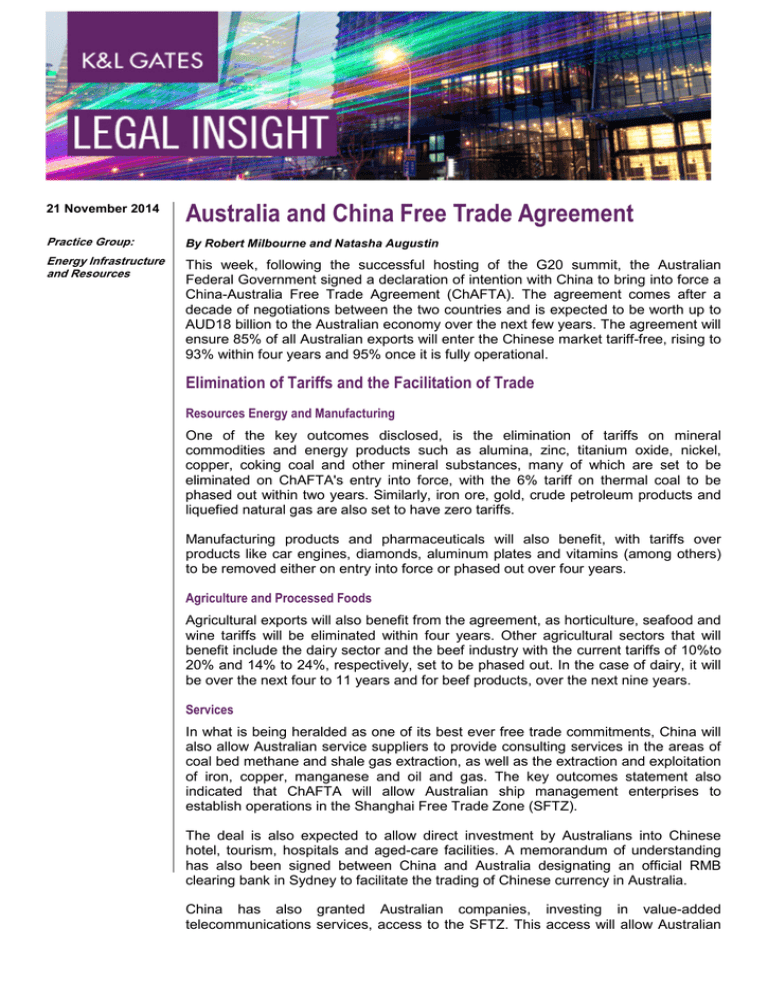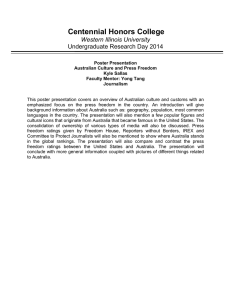
21 November 2014
Australia and China Free Trade Agreement
Practice Group:
By Robert Milbourne and Natasha Augustin
Energy Infrastructure
and Resources
This week, following the successful hosting of the G20 summit, the Australian
Federal Government signed a declaration of intention with China to bring into force a
China-Australia Free Trade Agreement (ChAFTA). The agreement comes after a
decade of negotiations between the two countries and is expected to be worth up to
AUD18 billion to the Australian economy over the next few years. The agreement will
ensure 85% of all Australian exports will enter the Chinese market tariff-free, rising to
93% within four years and 95% once it is fully operational.
Elimination of Tariffs and the Facilitation of Trade
Resources Energy and Manufacturing
One of the key outcomes disclosed, is the elimination of tariffs on mineral
commodities and energy products such as alumina, zinc, titanium oxide, nickel,
copper, coking coal and other mineral substances, many of which are set to be
eliminated on ChAFTA's entry into force, with the 6% tariff on thermal coal to be
phased out within two years. Similarly, iron ore, gold, crude petroleum products and
liquefied natural gas are also set to have zero tariffs.
Manufacturing products and pharmaceuticals will also benefit, with tariffs over
products like car engines, diamonds, aluminum plates and vitamins (among others)
to be removed either on entry into force or phased out over four years.
Agriculture and Processed Foods
Agricultural exports will also benefit from the agreement, as horticulture, seafood and
wine tariffs will be eliminated within four years. Other agricultural sectors that will
benefit include the dairy sector and the beef industry with the current tariffs of 10%to
20% and 14% to 24%, respectively, set to be phased out. In the case of dairy, it will
be over the next four to 11 years and for beef products, over the next nine years.
Services
In what is being heralded as one of its best ever free trade commitments, China will
also allow Australian service suppliers to provide consulting services in the areas of
coal bed methane and shale gas extraction, as well as the extraction and exploitation
of iron, copper, manganese and oil and gas. The key outcomes statement also
indicated that ChAFTA will allow Australian ship management enterprises to
establish operations in the Shanghai Free Trade Zone (SFTZ).
The deal is also expected to allow direct investment by Australians into Chinese
hotel, tourism, hospitals and aged-care facilities. A memorandum of understanding
has also been signed between China and Australia designating an official RMB
clearing bank in Sydney to facilitate the trading of Chinese currency in Australia.
China has also granted Australian companies, investing in value-added
telecommunications services, access to the SFTZ. This access will allow Australian
owned companies to supply domestic multi-party communication services,
application store services, store and forward services and call-centre services.
In the construction sector, Australian companies will be exempt from business scope
restrictions and have been granted market access to undertake joint construction
projects with Chinese parties in Shanghai. To support the growth of investment in the
infrastructure industry, new Investment Facilitation Arrangements will also be
introduced under Australia's existing visa system, for projects above AUD150 million,
to assist companies to respond to economic and labor market challenges. Finally,
legal firms will be able to establish commercial operations in the SFTZ that will be
allowed to service the whole of China.
Outstanding Issues
Australia has maintained its requirement that all investments by Chinese state-owned
enterprises be examined by the Foreign Investment Review Board (FIRB), despite
China’s request for an exemption.
An investor-state dispute settlement mechanism is also set to be put in place to
provide both governments with the ability to regulate investments in the public
interest, particularly where public health, safety and the environment are affected.
China allegedly has responded by maintaining its stance against increased access
for Australian rice, sugar, wheat and cotton. These issues are to be revisited in three
years when the deal is reviewed by each government.
It is also important to note that changes may still be made to the substance of the
arrangements. The text of the agreement is not yet available to the public and once
fully agreed, it will be reviewed and translated to both English and Mandarin before it
is signed by both nations. At this stage, it is estimated that the agreement will be
signed in 2015.
Review by the Foreign Investment Review Board
In line with Australia's free trade deals with the US and New Zealand, Australia is set
to lift the threshold for FIRB review of investment by privately held Chinese firms from
AUD248 million to AUD1.078 billion. However, the Australian Federal Government
has retained its discretion to screen Chinese investments in the areas of media,
telecommunications and defense related industries at lower thresholds.
Higher levels of scrutiny for agricultural land are to continue, with the threshold for
FIRB review decreasing from AUD200 million to AUD15 million and an AUD53 million
threshold introduced for the purchase of agribusiness. 1
Conclusion
The ChAFTA represents a major step forward in the already close relationship
between China and Australia, and may, when signed, herald changes that other
countries may seek to implement in broadening their free trade agreements. The
breadth and scope of this agreement will provide major changes into the industries
impacted, in particular in the energy, infrastructure and resources sectors.
Businesses should consider how to maximise the benefits, and be aware of the
1
http://www.abc.net.au/worldtoday/content/2014/s4130043.htm
consequences, as they plan for these changes and the subsequent reality that
goods, services, and supplies will all face new market entrants and changing market
dynamics going forward.
Authors:
Robert Milbourne
robert.milbourne@klgates.com
+61.7.3233.1203
Natasha Augustin
natasha.augustin@klgates.com
+61.8.9216.0918
Anchorage Austin Beijing Berlin Boston Brisbane Brussels Charleston Charlotte Chicago Dallas Doha Dubai Fort Worth Frankfurt
Harrisburg Hong Kong Houston London Los Angeles Melbourne Miami Milan Moscow Newark New York Orange County Palo Alto
Paris Perth Pittsburgh Portland Raleigh Research Triangle Park San Francisco São Paulo Seattle Seoul Shanghai Singapore
Spokane Sydney Taipei Tokyo Warsaw Washington, D.C. Wilmington
K&L Gates comprises more than 2,000 lawyers globally who practice in fully integrated offices located on five
continents. The firm represents leading multinational corporations, growth and middle-market companies,
capital markets participants and entrepreneurs in every major industry group as well as public sector entities,
educational institutions, philanthropic organizations and individuals. For more information about K&L Gates or
its locations, practices and registrations, visit www.klgates.com.
This publication is for informational purposes and does not contain or convey legal advice. The information herein should not be used or relied upon
in regard to any particular facts or circumstances without first consulting a lawyer.
© 2014 K&L Gates LLP. All Rights Reserved.







